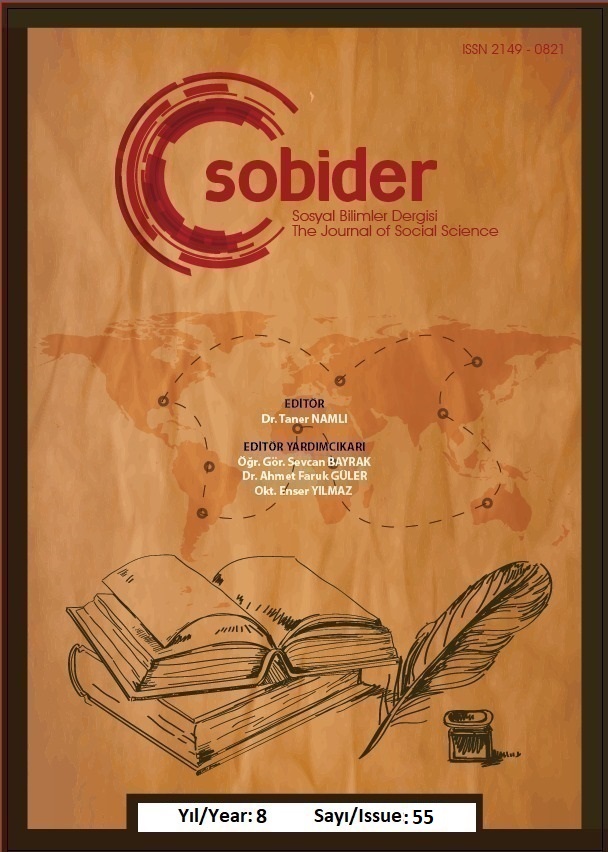Author :
Abstract
Sanat ve suç birbirinden iki ayrı tema gibi görünür. Ne var ki, sanatın özellikle çağdaş sanatların serüvenine baktığımızda ilginç kesişmeler olduğunu görürüz. Bazen sanatçılar toplumun ve hukuk sisteminin suç kabul ettiği işleri sanat yapıtı ya da performansı olarak sergilerler. Bu süreçlerin etik, estetik ve sosyolojik boyutları nelerdir? Suç ortaya çıktığı zaman sanat biter mi, yok mu olur? Konu bir yönüyle suç sosyolojisinin, diğer yönüyle sanat sosyolojisinin alanı içinde yer alır. Bu makalede disiplinlerarası bir yaklaşım ile çağdaş sanat dünyasından örneklerle tartışmamızı ve analizlerimizi gerçekleştireceğiz. Sanatçıların sanat otoriteleriyle karşı karşıya geldiği durumları ele alacağız. Kimin haklı olduğundan çok yapılan sıradışı performansların sosyolojik boyutlarını kavramsal olarak analiz edeceğiz. Yapacağımız araştırma ve analizler ise çağdaş sanat dünyasının ne kadar renkli ve çoğul olduğunu gösterecektir.
Keywords
Abstract
Art and crime seem like two separated themes. However, when we look at the adventure of art, especially contemporary art, we see that there are interesting intersections. Sometimes artists create some works of art or performances that society and the legal system consider as crime. What are the ethical, aesthetic and sociological dimensions of these processes? When the crime is revealed, does art finish or just disappear? On the one hand the topic is in the field of the sociology of crime, on the other hand in the sociology of art. In this article, we will discuss and analyze this through the examples from the contemporary art world with an interdisciplinary approach. We will focus on some situations where artists had confrontations with art authorities. We will conceptually analyze the sociological dimensions of extraordinary performances rather than discussing who is right. Our research and analysis will show how colorful and plural the contemporary art world is.
Keywords
- Artinfo24. (2020). https://www.artinfo24.com/kunstmarkt/news-1718.html Erişim: 07.11.2020
- Cambridge Dictionary. (2020). https://dictionary.cambridge.org/dictionary/english/at-the-end- of-the-day Erişim: 07.11.2020
- Chronıcle. (1996). Canadian Student Intentionally Vomits on 2 Famous Paintings. https://www.chronicle.com/article/canadian-student-intentionally-vomits-on-2-famouspaintings Erişim: 07.11.2020
- DESMOND, W. (2003). Art, Origins, Otherness / BetweenPhilosophyand Art. Albany, NY, ABD: StateUniversity of New York Press.
- Earle, G. (2014). A Moment Outside: A Study of Alexander Brener's Daring Escape from the Dictates of the Western Art Market. Journal of Arts and Humanities (JAH), Volume 3, No 1.
- Etnologue. (2020). https://www.ethnologue.com/guides/how-many-languages Erişim: 07.11.2020
- Gıbbons, F. (1999). Satirists jump into Tracey's bed". https://www.theguardian.com/uk/1999/oct/25/fiachragibbons1 Erişim: 07.11.2020
- Holum, E. (2020). Dadaism. https://www.eivindholum.no/categories-of- design/2019/2/20/dadaism Erişim: 07.11.2020
- Human Orıgıns. (2020). https://humanorigins.si.edu/evidence/human-fossils/species Erişim:
- Krohn, M. D. (Ed.) (2009). Handbook on Crime and Deviance, New York, ABD: Springer.
- Sccjr. (2020). Theories and causes of crime,http://www.sccjr.ac.uk/wp- content/uploads/2016/02/SCCJR-Causes-of-Crime.pdf Glasgow: İskoçya: The Scottish Centre for Crime & Justice Research,University of Glasgow. Erişim: 07.11.2020
- Schmalleger, F. (2020). What Is Criminology? Understanding Crime and Criminals. https://catalogue.pearsoned.ca/assets/hip/us/hip_us_pearsonhighered/samplechapter/013 3140660.pdf Erişim: 07.11.2020
- Tanner, J. (Ed.) (2003). The Sociology of Art / A Reader. New York, ABD: Routledge.
- Townsend, P. (2015). Creativity and Destructiveness in Art and PsychoanalysiS. British Journal of Psychotherapy, 31, 1.





